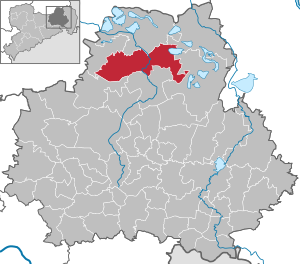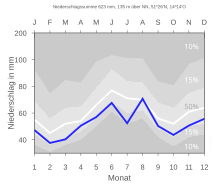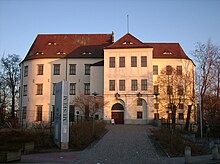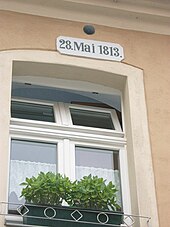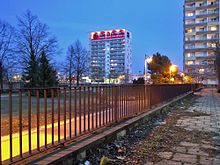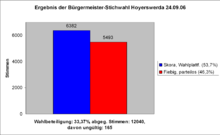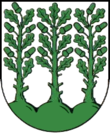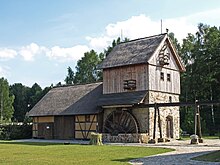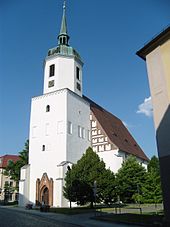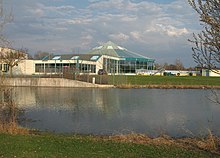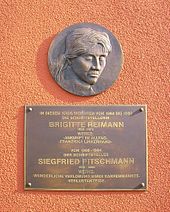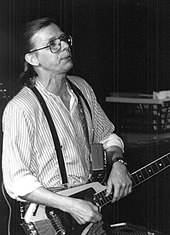Hoyerswerda
| coat of arms | Germany map | |
|---|---|---|

|
Coordinates: 51 ° 26 ' N , 14 ° 15' E |
|
| Basic data | ||
| State : | Saxony | |
| County : | Bautzen | |
| Height : | 117 m above sea level NHN | |
| Area : | 95.44 km 2 | |
| Resident: | 31,790 (Dec 31, 2020) | |
| Population density : | 333 inhabitants per km 2 | |
| Postal code : | 02977 | |
| Area code : | 03571 | |
| License plate : | BZ, BIW, HY, KM | |
| Community key : | 14 6 25 240 | |
| LOCODE : | DE HWE | |
| NUTS : | DED23 | |
City administration address : |
New town hall Salomon-Gottlob-Frentzel-Straße 1 02977 Hoyerswerda |
|
| Website : | ||
| Lord Mayor : | Torsten Ruban-Zeh ( SPD ) | |
| Location of the city of Hoyerswerda in the Bautzen district | ||
Hoyerswerda , Upper Sorbian , is a large district town in the Bautzen district in the Free State of Saxony . The third largest city in Upper Lusatia is located about 35 km south of Cottbus and 55 km northeast of Dresden in the Sorbian settlement area . The city is part of the Upper Central City Association of Bautzen , Görlitz and Hoyerswerda.
The settlement, which received town charter in 1423 , probably existed since the 12th century. However, Hoyerswerda remained a small town until the 1950s. It was only with the expansion of the lignite mining, processing and refining sites in the “energy district” of Cottbus after the city was destroyed in World War II. The residential complexes, characterized by prefabricated construction , were built, the population multiplied from around 7,000 after the Second World War to over 70,000. With the economic changes caused by German reunification, the population began to decline sharply. In 1991, the racially motivated riots in Hoyerswerda drew national and international attention to the city. Large-scale incorporations in the 1990s increased the urban area, and in 2019 the population was around 32,400.
geography
Geographical location
Hoyerswerda is located on the southern edge of the Lusatian Lakeland , which starts in the state of Brandenburg and runs in a south-easterly direction through eastern Saxony. The highest point of Hoyerswerda is 153 m above sea level. NN , the deepest 115 m (without structures).
The Lauta-Hoyerswerda-Wittichenau landscape protection areas (d 51), the Elster area around Neuwiese (d 52), the local recreation area Hoyerswerda (d 53) and the Spanntich Knappenrode are located in the urban area . Nature reserves in the vicinity are the Dubringer Moor southwest and the Knappensee (d 54) southeast of Hoyerswerda. As a protected landscape component is Werder area Dörgenhausen classified.
Expansion of the urban area
The extension of the urban area is 9 kilometers in north-south direction and 19 kilometers in east-west direction.
City structure
Hoyerswerda is divided into the old and new town and the following districts:
- Bröthen / Michalken (Upper Sorbian Brětnja / Michałki ), 1406 inhabitants
- Dörgenhausen (Němcy) , 672 inhabitants
- Knappenrode (Hórnikecy) , 705 inhabitants
- Schwarzkollm (Čorny Chołmc) , 792 inhabitants
- Zeißig (Ćisk) , 908 inhabitants
The Neustadt is divided into 14 districts: residential complexes I to VII, residential complexes VIII and IX (residential area "Kühnichter Heide"), residential complex X (residential area "Seidewinkel"), city center, Kühnicht (Kinajcht) , Grünewaldring and Gondelteich.
The old town is divided into 9 districts: Neida (Nydej) (consisting of Groß Neida and Klein Neida), Dresdner Vorstadt, Am Bahnhof, Am Stadtrand, An der Neupetershainer Bahn, An der Thrune, Innere Altstadt, Senftenberger Vorstadt and Spremberger Vorstadt.
Neighboring communities
Neighboring communities are (from the north in a clockwise direction) Elsterheide , Spreetal , Lohsa and the cities of Wittichenau , Bernsdorf and Lauta .
Hydrology
Among the waters of the first order, the Hoyerswerdaer Schwarzwasser flows first from the south into the Schwarze-Elster Canal, which begins southeast of Wittichenau , and a little later the original Schwarze Elster . This divides into the Alte Elster, which in turn joins the Kossackgraben in Neuwiese and flows into the old course of the Schwarzen Elster. Furthermore, the Bröthener See, the gondola pond and parts of the Scheibe See are in the urban area.
The following 2nd order waters are located in Hoyerswerda and its districts.
| Hoyerswerda | OT Bröthen / Michalken | OT Dörgenhausen | OT Knappenrode | OT Schwarzkollm | OT Zeißig |
|---|---|---|---|---|---|
| Thrunegraben, Winkelgraben, Waldgraben, Neidaer Graben, Feldgraben, Erlengraben, Schweissgraben Wudra, flood relief ditch, Büschingsgraben ( inflow of the gondola pond which in turn flows into the Schwarze Elster. ), Vincenzgraben , Schwarzer Graben, Kossackgraben ( starts at the level of the former train station hotel and runs from there underground through the Bahnhofsvorstadt, crosses Heinestrasse, Schulstrasse and Luxemburgstrasse before it comes to light behind the Heckertsiedlung west of the Senftenberger Vorstadt. |
Mühlgraben, Alter Wusckgraben, Wuschkgraben, Humenkgraben, Truschkagraben, Pantschelgraben, Grenzgraben, Winkelgraben, Michalkener Mühlgraben, Dorfgraben and Zuleiter, Stichgraben, Waldgraben A, Waldgraben B, Feldgraben, Poschergraben, Source Ditch |
Vincenzgraben, Erlengraben, Waldwiesengraben, Adlergraben, Feldgraben, Mittelteichabflussgraben, Schwarzwasser, Milaschgraben, Citroigraben, Bahnhofsgraben, Landwehrgraben, Grenzgraben, Michalkener Mühlgraben | Black trench | Schleichgraben, Leipper Mühlgraben, Graben C, Westschweißgraben, Ostschweißgraben, Kleinlaubuscher Graben, Steinteichgraben, Grenzgraben, Mittelwiesengraben A, Mittelwiesengraben B, Petzerberggraben, Dorfgraben, Fire Extinguishing Pond Ditch, Miesengraben, Weihergraben, Koscherkwgraben, Poscherkwgraben, Schwarzkollmerberggraben, Schwarzkollmerberg | Dorfgraben, Büschingsgraben. |
With the decline in lignite production and the closure of pits, the cessation of opencast mine drainage goes hand in hand. Therefore, the groundwater in the urban area has to be constantly raised and drained off via a ditch. The system consists of three horizontal filter wells, a pipeline network around five kilometers long and the open western edge trench that begins on the edge of Hoyerswerda and ends behind Nardt.
Hoyerswerda is located in the Lusatian glacial valley . The water table has long been flurnah, the area had Auencharakter. This was taken into account by the earlier master builders due to the original development in the old core of the city with houses without a basement and drainage ditches created above ground. With the opening of lignite opencast mines - also in the area around Hoyerswerda - at the beginning of the 20th century, the water table around the pits was lowered in order to be able to extract the coal. In the 1960s, filter well drainage systems were also added, which resulted in a lowering of the groundwater level by a further two to four meters to a level in some cases well below 114 m altitude zero (HN). In 1958, a binding height ordinate of 114 m above sea level was specified for new buildings, without paying sufficient attention to the pre-mining condition. With the erection of the prefabricated buildings in the new town, former trenches were filled and the houses with cellars were built. These would now be threatened by groundwater.
climate
The Hoyerswerda weather station is located on the northern outskirts in the river area of the Black Elster. The average annual precipitation from 1961 to 1990 is 623 mm and is therefore below the German average, with the exception of August. The driest month is February, the most precipitation falls in August.
story
Place name
The name Hoyerswerda is made up of two parts, Hoyer and Werda . Werda or Werder means island in a river or elevation in a damp lowland. Hoyer von Friedeburg was the first known owner of Hoyerswerda Castle. Since the mid-1990s, Hoyerswerda has been called Konrad-Zuse -Stadt, which is not part of the official spelling.
Colloquially (but also in casual press releases), Hoyerswerda is usually abbreviated as Hoywoy, formed from the initial syllables of the German and Sorbian place names. In Upper Sorbian the city is called Wojerecy , in Lower Sorbian Wórjejce , in Polish Wojerce , in Czech Hojeřice ; however, it is mostly referred to by the German name in Poland and the Czech Republic.
Historical overview
The area of Hoyerswerda was outside the Upper Lusatian old settlement area between Löbau and Kamenz, where the Slavic Milzeners had settled around 700 . The lowland of the Black Elster has been sparsely populated since the Germanic tribes left with the migration of the peoples. It was not until the 12th and 13th centuries that the area around Hoyerswerda was settled in the course of the second phase of the medieval country development . A large part of the colonists who established new villages here were Sorbs from the southern regions of Upper Lusatia. Archaeological excavations in the area of the castle in the 1980s have provided evidence that the first castle at this point was probably built before 1200. A church in Hoyerswerda is mentioned in a document from the Bishop of Meißen from 1225. 1268 Hoyerswerda is mentioned in the Upper Lusatian partition deed of the Margraves of Brandenburg . They assigned the western half of the rule Hoyerswerda to the country Budissin , while the eastern half came to the country Görlitz . The first known owner of the castle and manor was the Hoyer von Vredeberg, mentioned in a document in 1272 .
The place developed slowly because it was off the major trade routes. Its population was almost entirely rural, including only a few craftsmen who produced for local needs and for the residents of the stately castle. In 1353, Emperor Karl IV bought the rule of Hoyerswerda from Count Johann and Günther von Schwarzburg in order to strengthen the Bohemian rule over the Lusatia. This purchase was financed by the members of the Six Cities Association . In 1371 the emperor granted Hoyerswerda market rights , shortly afterwards he pledged the rule to his court marshal Thimo VIII von Colditz . In 1382 Benesch von Dauba received Hoyerswerda from King Wenzel as a hereditary fief. Heinrich von Dauba granted Hoyerswerda town charter and the right to freely elect a council in 1423 . Until the end of the old estate order in Upper Lusatia (1815), Hoyerswerda remained a manorial town, that is, the citizenship had to pay taxes to the owner of the estate and it was not represented in the state parliaments.
Heinrich von Duba often had an argument with Elector Friedrich von Sachsen ; he had Hoyerswerda occupied by his troops in 1430, but it was soon returned to Upper Lusatia. The new master was Friedrich von Schönburg , who had bought the fallen fief in 1437 from Emperor Sigismund . In the middle of the 15th century, Hoyerswerda was a small agricultural town and a local market for the area. In 1437 the emperor had given the city a fair. In 1449 the three-storey stone town hall was completed. Legally, the city was divided into the quarters under the jurisdiction of the council and the lordly Burglehn , in which the castle men had their houses.
Friedrich von Schönburg was one of the few supporters of the utraquist King of Bohemia, Georg von Podiebrad . The king helped him regain his rule in 1454 after Hoyerswerda had been taken again by the Saxon elector in 1448. After the Upper Lusatian estates broke up with King Georg, his remaining supporters gathered at Hoyerswerda Castle. That is why the Upper Lusatians began the siege in the autumn of 1467 under the leadership of Bailiff Jaroslav von Sternberg . In August of the following year, the castle garrison had to surrender and the fortress was torn down. Until 1490 the town and rule of Hoyerswerda remained in the hands of the bailiffs , then they were returned to the Schoenburgers by the new Bohemian King Vladislav II . In 1515, 1531 and 1571 the city burned down except for a few stone buildings.
In 1525 there were peasant riots in the rule of Hoyerswerda, which could only be put down with the help of troops from the Six Cities. Peasants' emissaries moved to Prague to appeal to the royal court against the increased interest and services, but they were turned away. In 1540 the Reformation was introduced in Hoyerswerda. Since the end of the 15th century, the Schönburgers tried to separate their rule from Upper Lusatia and to establish direct relationships with the crown of Bohemia. Above all, they no longer wanted to participate in the tax payments of the estates for the Bohemian king. Legally, the Schönburgers argued that, unlike the Upper Lusatian knighthood in Prague, they had received their fief directly from the king and therefore the rule of Hoyerswerda did not belong to Upper Lusatia at all. The estates complained against this interpretation and were confirmed in 1544 by King Ferdinand I in their opinion.
In 1567 Wilhelm von Schönburg died as the last descendant of his family and Hoyerswerda fell back to the king, who sold it to Heinrich von Maltitz . In order to preserve the city's freedoms, Hoyerswerda had to go to the Prague Court of Appeal in 1580 against the von Maltitz . In 1582 Seyfried von Promnitz bought the rule. In 1592 he had the palace, which had burned down three years earlier, rebuilt in the Renaissance style. In 1620 Rudolf von Ponickau acquired the town and castle of Hoyerswerda. Under the rule of his family, the city saw the transition from Upper Lusatia to Saxony (1621 and 1635). It was occupied and looted several times during the Thirty Years War (1628 and between 1631 and from 1642 almost every year). During this time, for the rule of Hoyerswerda of the country as the supreme royal officials for administrative, financial and judicial Amtshauptmann Seyfried (Siegfried) of Metzradt (1600-1660) detectable, which also landed gentry of Oberspremberg today Spremberg was. An epitaph with a corresponding inscription and coat of arms on the apse (outside) of the Spremberg village church commemorates the high electoral Saxon office bearer. In 1651 the Saxon Elector Johann Georg I bought Hoyerswerda. In 1680 the town hall was rebuilt in its present form after another fire in the town.
In 1705 August the Strong gave his temporary mistress Katharina von Teschen the rule of Hoyerswerda . The new mistress was an important patron of the town, especially of the local trade and handicrafts. She had the castle expanded and rebuilt in the baroque style. Katharina von Teschen directed the fortunes of Hoyerswerda for 32 years. During the Seven Years' War , on September 25, 1759, there was a battle near the city between Austrian and Prussian troops. In 1782, the forced labor in the rule of Hoyerswerda was abolished. The fields of the manorial Vorwerk of Hoyerswerda were leased to individual farmers in the area.
As a result of the Saxon participation in the Napoleonic Wars on the French side , Saxony had to cede the north and east of Upper Lusatia to Prussia in 1815. Initially, Hoyerswerda was designated the district town of the Brandenburg district of Spremberg . On August 1, 1825, the city was incorporated together with the southern district area as the district of Hoyerswerda in the province of Silesia . In 1873 the Hoyerswerda – Ruhland railway was opened by the Oberlausitzer Eisenbahn-Gesellschaft , which brought economic support as a large repair shop was also built. In 1912 Domowina was founded in Hoyerswerda. In 1945 Hoyerswerda was declared a fortress and heavily destroyed. The invading Red Army troops set fire to parts of the city.

Industrial housing construction 1955–1990
A few kilometers north of the city, the brown coal refining plant (combine) Schwarze Pump was built in 1955 , for whose employees living space had to be created. From 1957 the demand for apartments increased more and more, so for the first time living space was created in large block and panel construction . A socialist city emerged , called the 2nd Socialist City, with a total of ten residential complexes and tens of thousands of apartments. In 1981 the population of the city reached its maximum of 71,124 inhabitants.
Post-war industrial housing can be roughly divided into four sections. From 1955 to around 1959, around 2,000 apartments were built on the outskirts of the old settlement core of Hoyerswerda. From 1957 to 1965, seven residential complexes with around 1,200 apartments each were built, representing the original concept of the new town on the other side of the Elster. From 1966 to 1975, two more, much more densely built-up residential complexes with a total of over 6,000 apartments were built to the north-east of it. In the second half of the 1980s, residential complex 10 with around 2,000 apartments was built on the northern edge of Neustadt.
| construction time | Construction | Apartments | |
|---|---|---|---|
| Station forecourt | August 31, 1955-1958, 1970 | Brick construction, 1970 three-storey corner building in large block construction | about 350 |
| West edge development | 1956-1957 | Plastered brick buildings with hipped roofs, later prefabricated large brick blocks | about 850 |
| Elsterbogen | 1958-1959, 1961, 1963-1965 | 1958 brick construction, later large block construction | about 900 |
| Residential complex I | June 15, 1957-1964 | Large block construction | around 1200 |
| Residential complex II | 1957–1961, 1962/63, 1970 | 1957–1961 large block construction, 1962/63 P1 type, eleven storey in 1970 | around 1200 |
| Residential complex III | 1959 to 1961 | P1 type, the first eight-storey prefabricated residential buildings ever | around 1200 |
| IIIE (extension) | around 1975 | about 500 | |
| Residential complex IV | 1961/63, 1976, 1984 | P1 type, 1976 Y high-rise, 1984 cube houses | about 1400, about 200 (1976/1984) |
| Residential complex V | 1962-1964 | Change from the P1 type to the newly developed "Hoyerswerda" type | around 1290 |
| VE (extension) | WK VE five-, eight- and eleven-storey type P2 | around 1700 | |
| Residential complex VI | 1964/65 | around 1200 | |
| Residential complex VII | 1964/65, 1984 | the building concept for the new town decided in the fifties is completed three years late, but without the originally planned city center, 1984 cube houses | around 1160 |
| Residential complex VIII | 1966-1972 | 1966 “Hoyerswerda” prefabricated building type, 1967 conversion to type P2, now five-storey without elevators, no longer 150 inhabitants per hectare, but 300 | about 3400 |
| Residential complex IX | 1973-1975 | P2, five and eleven storeys | about 2700 |
| City center | 1968, 1975-1984 | eleven storeys | around 2100 |
| Residential complex X | 1986-1990 | WBS 70 , five and six storeys | around 2000 |
Due to the population decline that began after the fall of the Wall, the demolition of numerous residential units began in 1997. This is happening primarily in the three newer residential complexes, which are ultimately supposed to disappear completely. By January 31, 2007, 5535 apartments had already been demolished, and by 2020 there should be over 12,000. An exhibition in the House of History of the Federal Republic of Germany in Bonn in 2011 honors the construction work for the combine Schwarze Pump and the Neustadt of Hoyerswerda on an exhibition area of around 15 m².
After 1990

In 1990, the residents of the Hoyerswerda and Weißwasser districts decided in a citizen survey to belong to the Free State of Saxony , which was confirmed by both district assemblies.
In 1991 there were racially motivated riots in Hoyerswerda . Several dormitories for asylum seekers and contract workers were attacked. At the end of the rioting lasting several days, the migrants were assigned residences in other communities. The word " foreigner-free " coined in the process was chosen as the unword of 1991. As a result, many initiatives were launched to curb the right-wing extremist potential for violence.
In the years 1993 to 1998 the urban area was enlarged by incorporations. Since the population continues to decline, numerous prefabricated buildings in the Neustadt have been demolished since 1999. The residential complex X has meanwhile been completely dismantled except for a department store and a cube house (status: end of 2014). Until 1995, Hoyerswerda was the district town of the district of Hoyerswerda and after its dissolution on January 1, 1996, it received the status of an independent city , which it lost again during another district reform in August 2008. Since then, Hoyerswerda has been the second largest city in the Bautzen district .
For some years now, the population decline has slowed and the population has stabilized. After Cottbus , Görlitz and Bautzen , it is the fourth largest city in the German part of Lusatia .
Incorporations
- 1890 municipalities extension (Hamtske chěže), Burglehn and Haag
- 1957 communities Kühnicht and Klein Neida (with Groß Neida )
- July 1, 1993: Municipality of Bröthen (with Michalken )
- January 1, 1994: Municipality of Knappenrode
- January 1, 1996: communities Schwarzkollm (with Koselbruch, Petzerberg and Neukollm) and Zeißig (with Klein Zeißig)
- July 1, 1998: Dörgenhausen municipality
Population development
The population of Hoyerswerda rose only slowly in the Middle Ages and the early modern period . Due to the numerous wars, epidemics and famines it went back again and again. Until the middle of the 20th century, only a few thousand people lived in the city. After the construction of the Gaskombinat Schwarze Pump lignite refining plant in 1955, population growth accelerated rapidly. The population rose from around 10,000 in 1956 to its all-time high of over 71,000 in 1981. In the meantime, however, the population has fallen sharply again.
On December 31, 2018, the official population of Hoyerswerda was 32,658 (only main residences ) according to an update by the State Statistical Office of the Free State of Saxony . Since the change in the German Democratic Republic , the city has lost more than half of its population (around 36,000 people), mainly due to emigration due to high unemployment and, increasingly, due to the birth deficit. In relation to the city limits at that time, Hoyerswerda has even lost around 60 percent of its residents (over 40,000 people) since the end of 1988. In 2011, the TU Dresden forecast 28,700 inhabitants for Hoyerswerda in 2035.
Religions
Most of the residents of the city of Hoyerswerda are non-denominational. In the new town in particular, many Christians had abandoned their loose church ties at their new place of residence and the church members were only a small minority.
Evangelical Church in Germany
Three parishes belong to the EKD. These belong to the Evangelical Church of Berlin-Brandenburg-Silesian Upper Lusatia .
- Johannes Church Congregation
In addition to the old town, the Johannes parish includes around 10 districts and villages, some of which are Sorbian, in the immediate vicinity of the city. The Johanneskirche Hoyerswerda is one of the oldest buildings in the city. An Otto Bartning emergency church from 1951 serves as the parish hall and winter church. It was built on the foundation walls of the superintendent in 1947 as a so-called Swedish house and was given the name "Lutherhaus".
- Evangelical parish of Hoyerswerda-Neustadt
The Evangelical Parish Hoyerswerda-Neustadt includes the Neustadt Hoyerswerdas. The independent congregation was founded in early 1966 and took over a cemetery chapel built in 1902/1903 and converted it into the Martin Luther King House by September 1968. On October 8, 1989, the expanded Martin Luther King House in Hoyerswerda was inaugurated. In order not to endanger the ceremony with state representatives, no demonstrations took place beforehand. All Protestant pastors had been hostile-negative by the Stasi since 1970 because they were engaged in social and educational work for workers.
- Evangelical parish in Schwarzkollm
The Evangelical Parish of Schwarzkollm in the district of Schwarzkollm celebrated its 150th anniversary of the rededication of its church in 1860 in the church of Schwarzkollm in 2010 .
Catholic Church
Until 1540 there was also an Easter rider procession between Wittichenau and Hoyerswerda. With the introduction of the Reformation in Hoyerswerda on June 24, 1540, the religious life of Catholics at the town church (Johanneskirche) also came to a temporary end. Only from 1572 to 1580 did the rulers succeed in appointing a Catholic priest to the city church.
- Catholic parish "Holy Family"
Due to the immigration of Catholics through industrialization in Lusatia, a church building became necessary. On October 12, 1913, the foundation stone for the parish church of the Holy Family was laid. The consecration took place on May 25, 1914 by Auxiliary Bishop Karl Augustin from Breslau. In 1963 the organ, which is still played on a weekly basis, was re-voiced. With the construction of the new town and the immigration of Catholic repatriates from Upper Silesia in 1966, a second church building appeared necessary. From 1978 to 1980 the “Thomas More” community center was built in Kühnicht as one of the few new church buildings in the GDR. The church was built from prefabricated panels and was hardly recognizable as a church from the outside. The community center housed a convent of the Franciscan Sisters of Reute from 1991 to 2011 . The parish still includes the Catholic Curate “To the Holy Guardian Angels” Lohsa and the Catholic parish “St. Josef “Lauta outside Hoyerswerda.
- Catholic parish of St. Mariä Himmelfahrt Wittichenau-Kapelle Dörgenhausen
Since today's district of Dörgenhausen was owned by the St. Marienstern monastery , it remained Catholic even after the Reformation. The chapel in Dörgenhausen, built between 1952 and 1953, is still part of the Catholic parish of St. Mariä Himmelfahrt in Wittichenau .
Other denominations and religious communities
In addition to the Pentecostal Church with its Charismatic Center, the Apostle ministry of Jesus Christ in the former Kreuzkirche , the New Apostolic Church with its church that was consecrated in November 1992, the Jehovah's Witnesses with the Kingdom Hall and the community house of the regional church community, there are also meetings of the Evangelical Free Christ Congregation Hoyerswerda, the Free Church of the Seventh-day Adventists and the Evangelical Free Church Congregation (Brethren Congregation).
politics
City council
The city council consists of 30 members. In the past local elections , the following distribution of votes and seats resulted:
| Parties and voter communities | 2019 | 2014 | |||
|---|---|---|---|---|---|
| Share of votes | Seats | Share of votes | Seats | ||
| Christian Democratic Union of Germany (CDU) | 20.6% | 7th | 29.8% | 10 | |
| The left | 17.2% | 5 | 25.0% | 8th | |
| Social Democratic Party of Germany (SPD) | 13.3% | 4th | 13.2% | 4th | |
| Alliance 90 / The Greens (GREEN) | 3.8% | 1 | 1.3% | - | |
| Alternative for Germany (AfD) | 26.4% | 8th | - | - | |
| Free Democratic Party (FDP) | - | - | 1.9% | - | |
| National Democratic Party of Germany (NPD) | - | - | 4.4% | 1 | |
| Free voter association StadtZukunft | 10.3% | 3 | 16.2% | 5 | |
| Active Hoyerswerda | 8.5% | 2 | 8.2% | 2 | |
| total | 100% | 30th | 100% | 30th | |
| voter turnout | 54.8% | 38.6% | |||
Mayor
The first mayor after the Second World War was Arno Pinkau. He held office from 1955 to 1974.
In the election of the mayor on September 10, 2006, Stefan Skora (CDU) received 45.73% of the vote. Since he could not achieve an absolute majority, he had to run in a runoff election two weeks later against the individual applicant Sandro Fiebig and won it with 53.7%. Skora was put up as a candidate for “The Election Platform for Hoyerswerda”, which was made up of the city council factions of the CDU, FDP, Free Voters StadtZukunft and SPD. Skora's predecessor in office was Horst-Dieter Brähmig (PDS). In 2013, Skora was re-elected again after two ballots.
On September 6, 2020, the new mayor election took place, in which none of the candidates could achieve an absolute majority. In the second ballot on September 20, 2020, Torsten Ruban-Zeh ( SPD ) received the most votes with 44.3%, followed by Dorit Baumeister (electoral alliance for Dorit Baumeister ( Die Linke , Bündnis 90 / Die Grünen , Aktives Hoyerswerda)) with 33 , 4%, Marco Gbureck ( AfD ) with 16.2% and Claudia Florian ( CDU ) with 6.1%.
- List of Lord Mayors
|
coat of arms
In silver on green hills three green oak trees with leaves and fruits, the lower branches mutilated.
meaning
With the three green oaks, the city coat of arms of Hoyerswerda takes up a motif that was already used on the oldest known city seal. The oaks, Slavic dub , probably go back to the Berka von Dubá gentlemen , who owned the Hoyerswerda estate from 1382 to 1442 . The coat of arms itself is relatively young. In 1898 the heraldist Otto Hupp gave a coat of arms-like representation of the seal for German municipalities, including Hoyerswerda. This representation was later officially adopted after minor modifications.
Town twinning
As early as 1988, Hoyerswerda was able to ratify a partnership with the West German city of Dillingen / Saar . At the time of reunification , a city relationship with Pforzheim and Solingen was also concluded.
The partnership between the adult education centers in Hoyerswerda and the Finnish city of Huittinen was the reason for a partnership between the two cities in 1998. Similarly, in 2006 a partnership with the Polish Środa Wielkopolska district was established ; A partnership already existed between the Léon Foucault High School in Hoyerswerda and the Lyceum in the city of Środa Wielkopolska .
From the time before the incorporation, partnerships between Schwarzkollm and the Bavarian communities Heinersreuth and Stephanskirchen have existed since 1990 , and since 1980 between Zeißig and the Czech community Příkazy in the Okres Olomouc .
Culture and sights
Museums and libraries
The local museum of local history is located in Hoyerswerda Castle . Other museum facilities are the Zuse Computer Museum and the Knappenrode energy factory .
According to its own statements, the Brigitte-Reimann City Library takes second place in the performance comparison of the Saxon libraries.
Buildings and monuments

The old town of Hoyerswerda is a well-preserved small town area. The Lange Straße , a historic artisan alley from the 18th century, is particularly worth seeing . It is the oldest street in Hoyerswerda and in this form, with its single-storey closed development, is comparably rare in Germany.
Two sides of the historic market square have been preserved, two were destroyed in the Second World War. The old town hall was built in 1449 in the Renaissance style with a double flight of stairs and arched portal and was rebuilt in its current form in 1680 after a city fire. Before the town hall stands Sorbs Fountain by Jürgen von Woyski which until 1994 still in the courtyard of Ortenburg stood in Bautzen and Hoyerswerda translocated was. Relatively in the middle of the market square is the Saxon postal distance column with Prussian miles indicated after 1815 . The original part of the shaft is in the museum of the castle and the original piece of coat of arms in the Ringelnatzhaus in Wurzen .
The Hoyerswerda Castle is the oldest building in the city. It was built in the 13th century as a moated castle on an island in the valley of the Black Elster, served as a border fortification between Bohemia and Brandenburg until the 15th century and was completely destroyed in 1468 and 1589. After it was rebuilt into a three-storey renaissance castle, it was redesigned again in 1727 and served Princess Ursula Katharina von Teschen . In 1781 it became state property and has served as a public building ever since. as a royal district court and prison.
The new town of Hoyerswerda shows comparatively high-quality urban development from the GDR era in some areas. Particularly noteworthy is the park with an honorary grove for killed Soviet soldiers near the Lausitz Center with a large number of monuments and sculptural objects: sandstone column with flame bowl, bronze sculpture of a resisting person by the sculptor Jürgen von Woyski , sandstone tablets with inscriptions in memory of the victims of fascism - 135 Polish concentration camp inmates, presumably from the central warehouse in Niesky / meadow land of the Gross-Rosen concentration camp who were murdered during a death march in April 1945, just as the 102 German, Polish and Soviet soldiers who shortly before the war ended in Hoyerswerda and the surrounding Environment fell. The Hoyerswerda Planetarium in Neustadt was built in 1966/69 by citizens as part of the National Reconstruction Agency .
From 1975 to 1989, numerous sandstone sculptures were created at International Sculpture Symposia under the direction of Woyski, which are now on display in Hoyerswerda.
Outside the city center there is the Dörgenhausen post mill, built in 1707 near Teutschendorf, brought to Dörgenhausen in 1920 and in operation as a contract milling business from 1922 to 1942, the Zeißighof and the Krabat mill in Schwarzkollm .
The villages of Bröthen, Michalken and Zeißig each have their own war cemeteries.
Church buildings
- Protestant Johanneskirche , three-aisled, late Gothic hall church from the 14th century, oldest church in the city, burned out in 1945, later restored, with net and star vaults , western tower added in the 19th century
- Protestant Marienkirche Schwarzkollm , original Gothic church building (12th / 13th century), destroyed by fire in 1858 and rebuilt in the classicist - Romanesque style
- Protestant parish hall "Dr.-M.-Luther-King-Haus", built in 1902/1903 as a cemetery chapel, oldest building in Neustadt, from 1966 an independent Protestant parish in Neustadt, expanded in 1989 in GDR times, from a park with an old one Surrounded by trees
- Catholic parish church " Zur Heiligen Familie ", built in 1913/1914, neo-Gothic (in the style of the Brandenburg brick Gothic )
- Catholic Christ the King Chapel Dörgenhausen , built in 1952/1953, Gothic winged altar
- Catholic community center "St. Thomas More ”, church built from prefabricated building elements, consecrated in 1980, one of the few new churches in the GDR
- Kreuzkirche, built in 1754 as a rectangular hall with a hipped roof and a small ridge turret, originally as a burial church outside the city limits at that time, used as a hospital during the Wars of Liberation in 1813 , today the center of the Pentecostal community
- New Apostolic Church, consecrated in 1992
- Kingdom Hall of Jehovah's Witnesses
Parks
Among the parks are the Hoyerswerda Zoo and the Jürgen-von-Woyski-Park in the old town.
Natural monuments
- Teufelsmoor Schwarzkollm
- Gray heron colony
- Intermediate moor at Koselbruch
Regular events
- Music festival of the city of Hoyerswerda - the most traditional music festival in Lusatia that has been taking place continuously since 1966
- City festival
- Hoyschrecke song festival - began in 1997 as a songwriting festival with a competition
- Factory Festival - the Knappenrode energy factory
- Lusatian Lake District Fair - annual fair for outdoor, vacation, leisure and wellness since May 2010
- Krabat Cup - a sea sport competition that has taken place annually since 1995
Sports
In the "Sportbund Lausitzer Seenland - Hoyerswerda e. V. “51 sports clubs are organized. Important regional clubs are the LHV Hoyerswerda and the women's soccer team of the former SpVgg 1919 Hoyerswerda , which played in the regional league for a long time, and FC Lausitz Hoyerswerda , which missed promotion in the relegation games to the regional league in 1999 and 2000.
The Friedrich-Ludwig-Jahn-Sportpark and the Sportforum serve as sports facilities, the Lausitzbad Hoyerswerda and the local recreation area Bröthener See are among the pools.
Culinary specialties
In the region, many dishes are traditionally eaten or prepared with linseed oil such as cucumber salad, jacket potatoes and quark with linseed oil , Lusatian linseed cake with yoghurt, quark cake, pickled sheep's cheese, onion cake, fried potatoes, potato pancakes, sprout salad . Lusatian linseed oil is a geographically protected claim . The Lausitz oil mill in Hoyerswerda was founded in 1924. The whipping of linseed oil was already a traditional trade in Lusatia at that time.
Some restaurants also offer dishes from the Sorbian cuisine such as Sorbian wedding soup (egg dumplings, meatballs and vegetable strips) , quark with Lusatian linseed oil, Sorbian wedding dinner (boiled beef, horseradish sauce and bread or parsley potatoes) , elderberry soup and elements of GDR cuisine such as Soljanka and Schopska- Salad or hackers and grützwurst (here especially with buckwheat groats) of the Silesian cuisine .
regional customs
As in the whole of Lausitz, the customs and traditions of the Sorbs are preserved in the Hoyerswerda region. The bird wedding is celebrated on January 25th. At the time of Shrovetide, the Zampern is celebrated. The maypole raising and maypole throwing are particularly popular with the youth in the districts. Fetching Easter water, Easter singing, Easter bonfires and decorating Easter eggs are customs at Easter time.
Catholic men from the Dörgenhausen district take part in the Easter riding procession in Wittichenau . In many places there is a witch burning on Walpurgis Night .
Traditionally, two Sorbian costumes are at home in today's urban area . In addition to the traditional costume of the Sorbs around Hoyerswerda, the traditional costume of the Catholic Sorbs can be found in the Dörgenhausen district. Because of the Catholic Sorbian population, Corpus Christi is also a public holiday.
Dialect and usage
It is Niederlausitzer dialect speaking, a relatively good standard German . Furthermore, Hoyerswerda is located in the Upper Sorbian language area . A transition to the Lower Sorbian language is only a few kilometers north in about the line of the villages Zerre , Terpe , Sabrodt , Bluno , Proschim and Klein Partwitz . The Sorbian language is rarely passed on as a mother tongue here. It can be learned as a second language.
Economy and Infrastructure
traffic
The federal highway 96 from Zittau to Sassnitz and the federal highway 97 from Dresden to the Polish border at Guben cross the city. The distances to the next interchanges of federal motorways are:
The Nardt airfield is 5 km away, Dresden Airport 59 km.
Since the end of 2018, an eastern bypass connecting the B 96 in the south and the B 97 in the north has relieved the inner city of Hoyerswerda and the Zeißig district from through traffic and also significantly shortens the travel time between Bautzen and Cottbus. In the Federal Transport Infrastructure Plan since 1992 , construction began in May 2017. The second and final construction phase was opened to traffic on December 20, 2018. The 6.7 km long bypass cost around 20 million euros.
The city was the junction of several railway lines. The main route today still leads from Falkenberg / Elster to Węgliniec in Poland along the southern edge of the city center. To the northwest of the Hoyerswerda train station, the line to Neupetershain and to the southwest the line to Straßgräbchen – Bernsdorf and southeast the line to Bautzen branched off .
Hoyerswerda is in the tariff area of the Verkehrsverbund Oberelbe (VVO). Various bus and train lines lead to the two neighboring transport associations of Upper Lusatia-Lower Silesia (ZVON) and Berlin-Brandenburg (VBB). In SPNV two associate regional express -line to Dresden (RE 15) and Leipzig ( S 4 ) of DB Regio and RB line 64 Hoyerswerda - Niesky - Görlitz the East German railway . Since December 2004, Hoyerswerda has no longer had a direct train connection to Cottbus . Alternative connections are available every hour via Ruhland (RE 15 or S 4 to Ruhland, there change to Cottbus) or by bus (every hour from Monday to Friday, every two hours on weekends). In addition to the Hoyerswerda train station, there are also the Hoyerswerda Neustadt stop (OT Zeißig) and the train stations Knappenrode (OT Knappenrode) and Schwarzkollm (OT Schwarzkollm). The Hoyerswerda Neustadt stop and Hoyerswerda train station represent interfaces to other modes of transport. Knappenrode train station is not served.
Four bus lines operated by the Verkehrsgesellschaft Hoyerswerda (VGH) operate in the city of Hoyerswerda . From October 6, 1989 to December 30, 1994 the trolleybus Hoyerswerda operated in the city , it was the last new trolleybus operation in Germany to date. In regional traffic the VGH, Regionalbus Oberlausitz , the Verkehrsgesellschaft Oberspreewald-Lausitz and Neisseverkehr offer routes to the surrounding area and neighboring cities.
Long-distance buses connect Hoyerswerda with Berlin twice a day (travel time 2.5 hours) and once a day with Prague .
Established businesses
The region around Hoyerswerda has been going through a tremendous structural change since 1990. With the collapse of the dominant mono-industry - the mining and energy industries - drastic changes arose in Lusatia. In the region, 100,000 to 150,000 jobs have disappeared in all areas and were only slightly compensated. In 2012 there was an unemployment rate of around 13%, in Corona spring 2020 it was 8%. The high unemployment rate was accompanied by a high rate of emigration. At over 29%, the emigration rate has been the highest in Germany since 1989. The industry from the secondary sector has almost completely disappeared. According to statistics from the Child Protection Association on child poverty, Hoyerswerda is in third place in Germany.
Today, only a few large companies are located, although in Hoyerswerda, among others, to 1990, the Kombinat shauptsitze of construction and assembly combine coal and energy (the largest construction company in the GDR) and the housing combine were Cottbus (largest residential Kombinat) and operations of other conglomerates (such Example VEB Robotron -Elektronik Hoyerswerda, VEB Kraftverkehr Schwarze Pump - Hoyerswerda headquarters, VEB Möbelwerkstätten Hoyerswerda) were located in the urban area. Until the 2020s, it supplied 60% of the city with district heating .
The largest employers in Hoyerswerda are the city administration, Lausitzer Seenland Klinikum GmbH and Lausitzer Werkstätten für Behinderte non-profit GmbH.
The city of Hoyerswerda has had an integrated urban development concept drawn up in the areas of economy and urban redevelopment for its further economic development . In the urban redevelopment concept, the redesign, a - socially acceptable - downsizing process of the city, the dismantling of the vacant housing substance, a further development towards a modern residential and service provider city is designed. The economic concept sees the structural change in the surrounding area as an opportunity for Hoyerswerda. The goal is Hoyerswerda as the center and regional center of the Lusatian Lakeland , along with all the amenities of culture, educational and leisure facilities.
media
Local editions of the Lausitzer Rundschau and the Sächsische Zeitung appear in Hoyerswerda, and they get their material from the Hoyerswerdaer Tageblatt , an editorial team of the Hoyerswerda weekly newspaper publisher . In addition, the weekly courier appears once a week.
The local radio station LAUSITZWELLE Radio and the Sorbian Radio of the MDR are broadcast via the Hoyerswerda / Zeißig station. Around 300,000 people can receive LAUSITZWELLE radio in the transmission area. LAUSITZWELLE television offers a full 24-hour program with program sections repeated and can be received by 34,000 households in the region via numerous cable networks.
Public facilities
The event centers in Hoyerswerda are the Lausitzhalle Hoyerswerda with a capacity of 828 seats and the socio-cultural center Kulturfabrik Hoyerswerda e. V., called KUFA for short.
In Hoyerswerda there is a district court, a tax office, a police station, the Hoyerswerda fire brigade with professional fire brigade and 9 volunteer fire brigades as well as the Hoyerswerda branch of the Bautzen public prosecutor's office. An office for fire protection, rescue service and disaster control, the health department and a citizens' office of the Bautzen district office are also located in Hoyerswerda.
education
Hoyerswerda has four elementary and three secondary schools, a special school for the mentally handicapped, a special school for learning support, a special center for the disabled, a vocational school center, a training center for medical and social professions, a vocational school center / vocational special school, the Konrad Zuse Academy Hoyerswerda (one private university in cooperation with Mittweida University ) and three grammar schools.
There is also an adult education center and two music schools. The Lausitz Children's University is also located here.
Hoyerswerda in art
Literature and opera
The unfinished novel " Franziska Linkerhand " by the writer Brigitte Reimann , whose setting is largely in Hoyerswerda, was published in 1974 and 1998 as a complete edition based on a typescript that has been handed down:
It's the 1960s in the GDR. The young architect Franziska Linkerhand is fleeing a failed marriage or looking for new challenges in Neustadt. A city that will be reinvented on the green meadow, the young architect thought and dreamed of bright and friendly residential areas. In fact, gray, dreary and uniform blocks were pounded into the ground. The young woman, driven by idealism, quickly realized that life in these new parts of the city was also gray and dreary. Alcohol abuse, violence and suicide gradually crumbled her dreams.
Linkerhand , an opera by Moritz Eggert , loosely based on the novel by Brigitte Reimann, with the libretto by Andrea Heuser , under the musical direction of Eckehard Stier, and directed by Sebastian Ritschel, was opened in May 2009 at the end of the 44th Lusatian Music Festival in the Lausitzhalle Hoyerswerda in a production of the Theater Görlitz world premiere.
music
The songwriter and rock musician Gerhard Gundermann dedicated two songs to Hoyerswerda.
- HOY WOY - LP: MEN, WOMEN AND MACHINERY, 1988
- HOY WOY II - CD: TORERO. WERKSTÜCKE III Recordings from several concerts in different places at very different times, 2005
Movie
The Koselbruch in the district of Schwarzkollm is the action location, but not a location for the Czechoslovak animation film Krabat (1977), the DEFA film The Black Mill (1975) and the film Krabat (2008) based on the novel of the same name by Otfried Preußler. (see also: Krabat-Mühle Schwarzkollm )
Personalities
Honorary citizen
Since 1917 nine people have been made honorary citizens. The two best known are Wilhelm Pieck and Konrad Zuse .
sons and daughters of the town
- Johann Karl Wilhelm Alt (1797–1869), Protestant theologian
- Hans von Nitsche (1855–1927), major general
- Rudolf von Sebottendorf (1875–1945), founder of the anti-Semitic and ethnic Thule Society
- Günter Peters (1907–1987), painter and zoo director, museum director from 1952 to 1975
- Hermann Mau (1913–1952), historian, teacher and university lecturer
- Herbert Härtel (1921-2005), Indologist
- Kurt Klinkert (1927–2004), painter
- Horst-Dieter Brähmig (1938–2017), local politician (Die Linke); from 1994 to 2006 mayor of Hoyerswerda
- Gertrud Winzer , also Gertraud Winzer (* 1940 in Kühnicht), politician (CDU), MdL
- Rainer Nachtigall (* 1941), soccer player of the GDR
- Dietmar Hötger (* 1947), judoka
- Rolf Babiel (1952–2009), well-known restaurateur in New York City
- Detlef Bielke (* 1952), fusion musician
- Michael Schiewack (* 1952), journalist
- Karin Schmidt (* 1955), politician (Die Linke), member of the state parliament of Mecklenburg-Western Pomerania
- Petra Pfaff (* 1960), athlete
- Frank Hirche (* 1961), politician (CDU), MdL
- Ingolf Krause (* 1961), soccer player
- Karsten Hilse (* 1964), politician (AfD)
- Ingrid Mattern (* 1964), politician
- Steffen Rietschel (* 1965), soccer player
- Thomas Hoßmang (* 1966), soccer player
- Roland Hennig (* 1967), racing cyclist
- Cornelia Kraske (* 1969), fashion designer and costume designer
- Vera Meyer (* 1970), biotechnologist
- Thomas Ziesch (* 1971), actor
- Ronny Fischer (* 1972), soccer player
- Mike Hauschild (* 1972), politician
- Silvio Nickol (* 1975), chef, awarded two stars in the Michelin Guide
- André Thieme (* 1975), show jumper
- Marcel Rozgonyi (* 1976), football player
- Matthias Heidrich (* 1977), soccer player
- Gabor Gallai (* 1979), football coach
- Natalie Langer (* 1981), TV presenter
- Evelyn Schmidt (* 1983), German Wine Queen 2007/08
- Stefanie Karg (* 1986), volleyball player
- Monique Braun (* 1989), soccer player
- Tom Mickel (* 1989), soccer player
- Tony Jantschke (* 1990), soccer player
- Matti Oehl (* 1990), jazz musician
- Eric Oelschlägel (* 1995), soccer goalkeeper
- Marvin Stefaniak (* 1995), football player
Personalities who worked in Hoyerswerda
- Salomon Gottlob Frentzel (1701–1768), clergyman and regional historian
- Joseph Werminghoff (1848–1914), entrepreneur, today's OT Knappenrode was named after him from 1913 to 1950
- Max Wockatz (1898–?), NSDAP district leader in Hoyerswerda from 1934 to 1945
- Richard Paulick (1903–1979), architect
- Werner Masseck (1914–1962), NDPD member of the People's Chamber
- Brigitte Reimann (1933–1973), writer
- Friedhart Vogel (* 1941), Protestant clergyman and honorary citizen of Hoyerswerda
- Ingrid Raack (* 1954), singer and presenter
Personalities who temporarily lived in Hoyerswerda
- Jan Henryk Dąbrowski (1755-1818), Polish general and national hero (grew up here)
- Konrad Zuse (1910–1995), computer pioneer (graduated from high school here)
- Rochus Misch (1917–2013) radio operator, Hitler's bodyguard (learned to be a painter here)
- Gisela Helmecke (* 1951 in Plauen), art historian (graduated from high school here)
- Bernhard Kremser (* 1954 near Dresden), sculptor, designer, graphic artist and actor (attended Lessing High School here and passed his Abitur)
- Gerhard Gundermann (1955–1998), songwriter and rock musician (high school graduation, life and musical work until 1987, burial site in the cemetery in Hoyerswerda)
literature
- Felix Richter: The New Hoyerswerda. Budget of ideas, structure and discourse of the second socialist city of the GDR. urbanophil Verlag, Berlin 2020, ISBN 978-3-9820586-1-0 . (urbanophil.net)
- Stefan Boness : Hoyerswerda - the shrinking city. Jovis-Verlag, Berlin 2012, ISBN 978-3-86859-196-5 .
- Peter Biernath (Ed.): Architektour Hoyerswerda: Architektur Hoyerswerda . Hoyerswerda 2005.
- Urban redevelopment east, super redevelopment Hoyerswerda , ed. from the Saxon Academy of the Arts in cooperation with the city of Hoyerswerda. (Editing: Klaus Michael & Kirsten Böhme). Dresden 2005, ISBN 3-934367-07-0 .
- Elke Roschmann: The castle in Hoyerswerda. On history and social function . (= Hoyerswerda history booklet. 32). Hoyerswerda 1989.
- Günter Meusel: On the settlement history of the Hoyerswerda district in the High Middle Ages . (= Hoyerswerda history booklet. 21). Hoyerswerda [1982].
- Salomon Gottlob Frentzel: Historical show place or chronicle and description of the royal and electoral Saxon city and rule Hoyerswerda in Marggraffthume Ober-Laußitz . Leipzig / Bautzen 1744.
- Samuel Martini: The unexpected guest or sermon on fire. When in ... Hoyerswerda in Marggraffthumb Ober-Lausitz ... a terrible fiery heat arose ... in the church preserved by divine grace kept simple . London 1679.
- Helga Müller: Hoyerswerda - my life. Memories of the years 1936 to 1951 . Niederlausitzer-Verlag, Guben 2008, ISBN 978-3-935881-59-3 .
- Detlef Pollack : The xenophobic riots in Hoyerswerda ten years ago. In: Berlin Debate INITIAL. No. 16, 2005, pp. 15-32.
- August Ernst Schuster: An attempt at a history of the city of Hoyerswerda, from its origins to the most recent times . Ihring, Hoyerswerda 1842. (digitized version)
- Georg Werchan: Hoyerswerda. In: Scholz: Heimatbuch des Kreis Hoyerswerda. Verlag Ziehlke, Bad Liebenwerda 1925, pp. 215–244. ( Digitized version )
Web links
Individual evidence
- ↑ Population of the Free State of Saxony by municipalities on December 31, 2020 ( help on this ).
- ↑ a b City portrait - cityscape - statistics - population by district. (PDF) In: Hoyerswerda.de. Retrieved January 7, 2020 .
- ↑ City of Hoyerswerda zoning plan 2006 ( Memento from May 25, 2011 in the Internet Archive )
- ↑ Codex diplomaticus Lusatiae superioris. Collection of the documents of the Markgrafthum Oberlausitz, Part I, Volume 1, No. 58. Görlitz 1851.
- ^ Document printed in: Benjamin Gottfried Weinart : Neue Sächsische Historische Handbibliothek, Part 2. Leipzig 1784, p. 228.
- ↑ Frentzel: Historical location…. P. 39.
- ↑ Display board in the museum in Hoyerswerda Castle
- ↑ Stefan Skora, Dietmar Wolf: Demographic change at the municipal level using the example of the city of Hoyerswerda. ( Memento from May 20, 2011 in the Internet Archive ) Presentation slides from December 17, 2007 (PDF; 9.3 MB)
- ↑ Anita Katzbach: People have other problems. (No longer available online.) In: Jungle World. nadir.org, archived from the original on March 11, 2008 ; Retrieved July 2, 2010 .
- ^ Simone Rafael: Climate change in Hoyerswerda. How an active civil society fights for the children of their city. Federal Agency for Civic Education , July 6, 2007, accessed on July 2, 2010 .
- ^ Hoyerswerda in the Digital Historical Directory of Saxony
- ↑ Mirko Kolodziej: Hoyerswerda 2050: More than half are old. In: Lausitzer Rundschau . September 10, 2011.
- ↑ Herbert Willems (Ed.): Theatricalization of society. Volume 1: Sociological Theory and Diagnosis of Time. Wiesbaden 2009, ISBN 978-3-531-91442-8 , p. 360.
- ↑ Hoyerswerda - Election results - Mayor election 2020 Second ballot. hoyerswerda.de, accessed on September 21, 2020 .
- ↑ Torsten Ruban-Zeh is the new Lord Mayor of Hoyerswerda. mdr.de, accessed on September 21, 2020 .
- ↑ Eckhart Leisering: Coats of arms of the independent cities and districts in the Free State of Saxony . mdv, Mitteldeutscher Verlag, Halle / Saale 2000, ISBN 3-89812-069-4 , p. 30th f .
- ↑ Silver for Hoyerswerda - second in Saxony. Brigitte-Reimann City Library, accessed on February 25, 2012 .
- ↑ Hoyerswerda Music Festival is in its 45th year. In: Lausitzer Rundschau. March 17, 2010, accessed February 7, 2018 .
- ↑ Ceremonial start of construction for the expansion of the Hoyerswerda bypass (B96). Free State of Saxony, Saxon State Chancellery, May 3, 2017, accessed on August 20, 2021 .
- ↑ Free travel on the eastern bypass. City of Hoyerswerda, December 20, 2018, accessed on August 20, 2021 .
- ↑ Unemployment rate in Hoyerswerda rises. In: Lausitzer Rundschau. June 29, 2012, accessed December 5, 2020 .
- ↑ Official unemployment rate at 7.7 percent. In: Hoyerswerdaer Tageblatt / Sächsische Zeitung . June 3, 2020, accessed December 5, 2020 .
- ↑ Real-time online. Retrieved August 1, 2008 .
- ↑ https://www.youtube.com/watch?v=nBfz8R1SRhk With the energy transition in the blackout? - How the power grid needs to change , MDR , February 2021
- ↑ Bernd Hannemann: Kinder Uni deals with the red list. In: Lausitzer Rundschau . May 23, 2011.
- ^ Conversations lexicon of the latest time and literature . FA Brockhaus, 1832 ( google.de [accessed on February 22, 2020]).
- ↑ Rochus Misch : The last witness . Pendo Verlag , Munich 2008, ISBN 978-3-86612-194-2 .
- ^ Gerhard Rüdiger Gundermann: Self-made curriculum vitae, status: February 1996. Gundermanns Seilschaft eV, accessed on May 22, 2014 .

